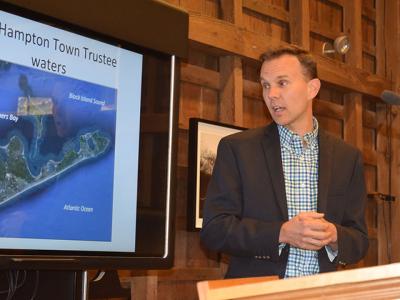Water Report Mostly Positive

Waterways under the jurisdiction of the East Hampton Town Trustees are mostly healthy, and some that are seasonally or permanently closed to shellfishing might be safely opened, according to Christopher Gobler of Stony Brook University’s School of Marine and Atmospheric Sciences.
Dr. Gobler delivered his 2017 findings to the East Hampton Town Trustees, who have engaged him to monitor trustee-managed water bodies for the last five years, at their meeting on Monday. A group of property owners surrounding Georgica Pond has also hired Dr. Gobler to study and make recommendations to combat the toxic blue-green algae blooms that have afflicted it during the past several summers.
Salinity across the sites he monitors for the trustees was “fairly high” in 2017, Dr. Gobler reported. “These water bodies are being well flushed with ocean-like water,” maintaining that salinity, he said, which is “a very good sign” for healthy waterways. All sites also showed “very good” levels of dissolved oxygen, though those levels fluctuate from day to night, when they typically fall.
In another positive sign, all monitored sites showed low levels of chlorophyll last year, Dr. Gobler said. Excessive nutrients in a water body, often caused by runoff of sewage, animal waste, or fertilizers from the land, can promote the algal blooms that deplete oxygen and cause fish kills.
Only at the head of Three Mile Harbor, Dr. Gobler said, was fecal coliform bacteria measured above a concerning threshold. Measurements of fecal coliform bacteria by the culvert in Accabonac Harbor, which the trustees recently opened to promote tidal flushing, were low, he said, suggesting that that action has been effective.
In general, the State Department of Environmental Conservation “has it right for most locations” where it has closed a waterway to shellfishing on a seasonal basis, he said. Some of these could potentially be reopened, though he did caution that the D.E.C.’s sampling is more rigorous than his own. As an example, when he took his first samples in 2013, all of Northwest Creek was uncertified, or permanently closed. “Our first-year data suggested that could be eased,” he said. The following year, the northern half of the creek was opened seasonally. An area of Hand’s Creek that is closed to shellfishing “seems to be pretty clean,” he said, as does the southern portion of Hog Creek.
Harmful algal blooms were sparse in 2017, Dr. Gobler said, with just one low-level sample of alexandrium, which can produce a toxin leading to paralytic shellfish poisoning, at the head of Three Mile Harbor. Dinophysis, which is harmful to shellfish, was not detected last year, he reported.
The news was not as positive for cochlodinium, or rust tide, with “some very high detects” at the head of Three Mile Harbor and one high level measured in Accabonac Harbor. Last year, though, was milder than 2016, he said. Cochlodinium can be lethal to finfish and bivalves.
Three Mile Harbor experiences the highest rate of nitrogen loading among East Hampton’s water bodies, and the relationship between excessive nutrients and algal blooms is clear, Dr. Gobler said. On a positive note, however, groundwater travel times around the harbor are relatively fast compared to other parts of Long Island. That means that “rapid action would lead to rapid results.” Addressing nitrogen from wastewater “could have a rapid effect on that region,” suggesting that allocating a portion of the community preservation fund to water quality initiatives, which voters approved in a 2016 referendum, is advisable. State-of-the-art nitrogen-reducing septic systems, which Suffolk County recently approved, would also help, he said.
Cyanobacteria, or blue-green algae, were measured below the D.E.C. standard for safety, Dr. Gobler said, with the lone exception of a brief period, in June, in Georgica Pond. The Friends of Georgica Pond Foundation, the group of pondfront property owners, leased and operated an aquatic weed harvester to remove macroalgae from the pond in 2016 and again last year.
As macroalgae decay, they provide nutrients to harmful algae such as cyanobacteria. “The hypothesis is that’s pulsing massive amounts of nutrients into the water,” and cyanobacteria “love recycled and regenerated nutrients.” The removal in 2016 of more than 55,000 pounds of macroalgae from Georgica Pond may have contributed to the substantial reduction in cyanobacteria last year, when a harvester removed an additional 32,700 pounds. “So far, it looks like it’s beneficial” in discouraging cyanobacteria, he said.
Dr. Gobler also referred to the recent report of the microbial source-tracking he has conducted at several sites in Georgica Pond, aimed at identifying specific sources of coliform bacteria. While human-based bacteria are getting into the pond, he said, waste from birds, deer, and canines represent a far greater share. That research will expand and continue this year, he said.
